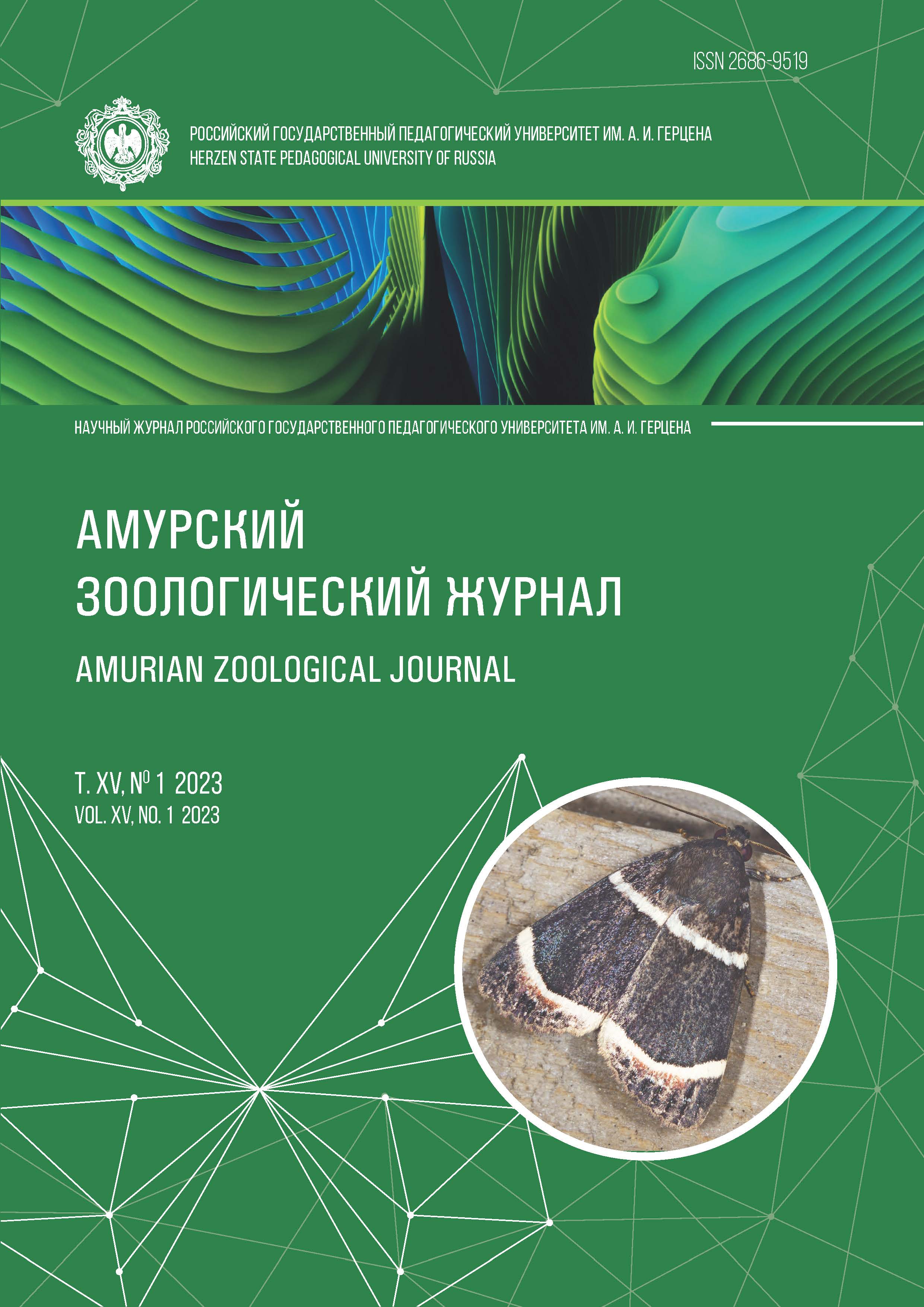Первая находка Giardia duodenalis (Giardiinae, Diplomonadida, Metamonada) у кавказской агамы (Paralaudakia caucasia) в Азербайджане
DOI:
https://doi.org/10.33910/2686-9519-2023-15-1-77-81Ключевые слова:
кавказская агама, Giardia duodenalis, циста, лямблиоз, зоонозАннотация
В Азербайджане кавказкая агама (Paralaudakia caucasia) впервые отмечена как хозяин зоонозных цист Giardia duodenalis. В весенний и летний сезоны 2020 года были отловлены 27 кавказских агам (Paralaudakia caucasia). Отлов проводили в период их активности в разных участках Гобустана (к югу от Баку, на территориях Карадагского и Апшеронского районов Азербайджана). В фекалиях пяти особей из 27 кавказской агамы были найдены цисты G. duodenalis. Размеры цист 14,86 ± 0,63 х 12,62 ± 0,74 (мкм), ИФ = 1,08 ± 0,04. Интенсивность инвазии была невысокой, от 8 до 15 цист в препарате. Для оценки степени загрязнения окружающей среды этими паразитами впервые использован метод McMaster. Количество цист в 1 г фекалий варьировал от 1250 до 7350.
Библиографические ссылки
Alekperov, A. M. (1978) Zemnovodnye i presmykayushchiesya Azerbajdzhana [Amphibians and reptiles of Azerbaijan]. Baku: Elm Publ., 264 p. (In Russian)
Ahmedov, S. B., Novruzov, N. E. Chislennost’, raspredelenie i aktivnost’ kavkazskoj agamy Laudakia Caucasia (Sauria, Agamidae) v vostochnoj chasti Azerbajdzhana [Abundance, distribution and activity of the Caucasian agama Laudakia Caucasia (Sauria, Agamidae) in the eastern part of Azerbaijan]. Trudy Zoologicheskogo Instituta — Proceedings of the Zoological Institute, vol. 35, no. 1, pp. 126−134 (In Russian)
Cama, V. A., Mathison, B. A. (2015) Infections by intestinal Coccidia and Giardia duodenalis. Clinics in Laboratory Medicine, vol. 35, no. 2, рр. 423−444. https://doi.org/10.1016/j.cll.2015.02.010 (In English)
Carignan, V., Villard, M. A. (2002) Selecting indicator species to monitor ecological integrity: a review. Environmental Monitoring and Assessment, vol. 78, no. 1, pp. 45−61. https://doi.org/10.1023/a:1016136723584 (In English)
Chagas, C. R., Gonzalez, I. H., Salgado, P. A. et al. (2019) Giardia spp., ten years of parasitological data in the biggest zoo of Latin America. Ann Parasitol, vol. 65, no. 1, pp. 35−51. https://doi.org/10.17420/ap6501.181 (In English)
Cringoli, G., Rinaldi, L., Veneziano, V. et al. (2004) The influence of flotation solution, sample dilution and the choice of McMaster slide area (volume) on the reliability of the McMaster technique in estimating the faecal egg counts of gastrointestinal strongyles and Dicrocoelium dendriticum in sheep. Veterinary Parasitology, vol. 123, no. 1-2, pp. 121–131. https://doi.org/10.1016/j.vetpar.2004.05.021 (In English)
Filice, F. P. (1952) Studies on the cytology and life history of a Giardia from the laboratory rat. University of California publications in zoology, vol. 57, pp. 53 — 146 p. (In English)
Greene, H. W. (1988) Antipredator mechanisms in reptiles. In: C. Gans, R. B. Huey (eds.). Biology of the Reptilia. Vol. 16. Ecology B, Defense and Life History. New York: Alan R Liss Publ., pp. 1−152. (In English)
Leung, A. K., Leung, A. A., Wong, A. H. et al. (2019) Giardiasis: An overview. Recent patents on inflammation & allergy drug discovery, vol. 13, no. 2, pp. 134−143. https://doi.org/10.2174/1872213X13666190618124901 (In English)
Mendoza-Roldan, J. A., Modry, D., Otranto, D. (2020) Zoonotic parasites of reptiles: a crawling threat. Trends in Parasitology, vol. 36, no. 8, pp. 677−687. https://doi.org/10.1016/j.pt.2020.04.014 (In English)
Reboredo-Fernandez, A., Ares-Mazas, E., Galan, P. et al. (2017) Detection of zoonotic and livestock-specific assemblages of Giardia duodenalis in free-living wild lizards. Brazilian Journal of Veterinary Parasitology, vol. 26, no. 3, pp. 395−399. https://doi.org/10.1590/S1984-29612017034 (In English)
Savioli, L., Smith, H., Thompson, A. (2006) Giardia and Cryptosporidium join the “Neglected Diseases Initiative”. Trends in Parasitology, vol. 22, no. 5, pp. 203–208. https://doi.org/10.1016/j.pt.2006.02.015 (In English)
Schnell, K., Collier, S., Derado, G. et al. (2016) Giardiasis in the United States — an epidemiologic and geospatial analysis of county-level drinking water and sanitation data, 1993–2010. Journal of Water and Health, vol. 14, no. 2, pp. 267–279. https://doi.org/10.2166/wh.2015.283 (In English)
Sheather, A. L. (1923) The detection of intestinal protozoa and mange parasites by a flotation technique. The Journal of Comparative Pathology and Therapeutics, vol. 36, pp. 266–275. https://doi.org/10.1016/S0368-1742(23)80052-2 (In English)
Thompson, R. C., Lymbery, A. J., Meloni, B. (1990) Genetic variation in Giardia Kunstler, 1882: Taxonomic and epidemiological significance. Protozoological Abstracts, vol. 14, no. 1, pp. 1–28. (In English)
Upton, S. J., Zien, C. A. (1997) Description of a Giardia varani-like flagellate from a water monitor, Varanus salvator, from Malaysia. Journal of Parasitology, vol. 83, no. 5, pp. 970–971. (In English)
Zinsstag, J., Schelling, E., Waltner-Toews, D., Tanner, M. (2011) From “one medicine” to “one health” and systemic approaches to health and well-being. Preventive Veterinary Medicine, vol. 101, no. 3–4, pp. 148–156. https://doi.org/10.1016/j.prevetmed.2010.07.003 (In English)
Загрузки
Опубликован
Выпуск
Раздел
Лицензия
Copyright (c) 2023 Гурбанова Тюркан Фирудин кызы

Это произведение доступно по лицензии Creative Commons «Attribution-NonCommercial» («Атрибуция — Некоммерческое использование») 4.0 Всемирная.
Авторы предоставляют материалы на условиях публичной оферты и лицензии CC BY 4.0. Эта лицензия позволяет неограниченному кругу лиц копировать и распространять материал на любом носителе и в любом формате в любых целях, делать ремиксы, видоизменять, и создавать новое, опираясь на этот материал в любых целях, включая коммерческие.
Данная лицензия сохраняет за автором права на статью, но разрешает другим свободно распространять, использовать и адаптировать работу при обязательном условии указания авторства. Пользователи должны предоставить корректную ссылку на оригинальную публикацию в нашем журнале, указать имена авторов и отметить факт внесения изменений (если таковые были).
Авторские права сохраняются за авторами. Лицензия CC BY 4.0 не передает права третьим лицам, а лишь предоставляет пользователям заранее данное разрешение на использование при соблюдении условия атрибуции. Любое использование будет происходить на условиях этой лицензии. Право на номер журнала как составное произведение принадлежит издателю.







